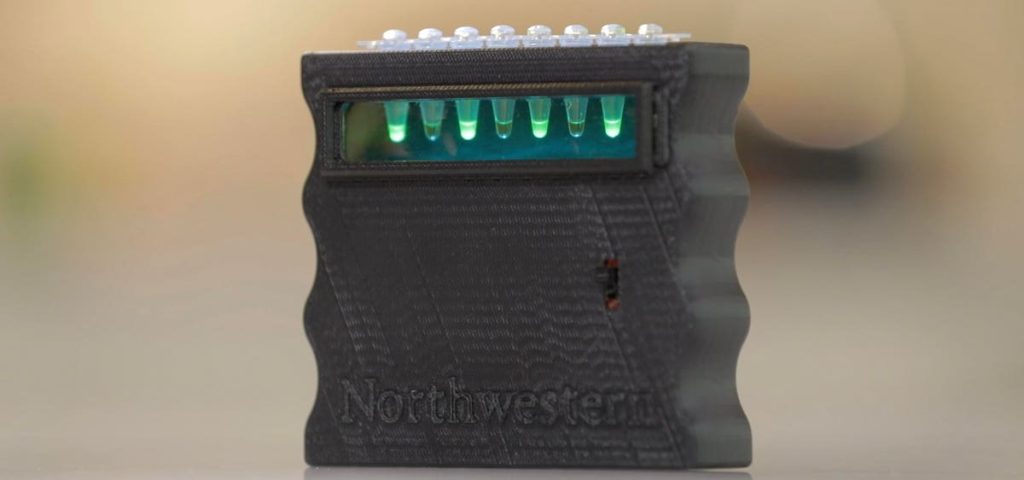The National Science Foundation is backing a pilot study by Northwestern University to develop and distribute water quality testing kits to Chicago-area residents. Other big cities could be next.
The foundation awarded a $3 million grant to the university. Later this year, 350 households will receive handheld, easy-to-use test kits to assess their home water quality. The tests will be available first for lead, and later for copper and PFAS.
PFAS is short for per- and polyfluoroalkyl substances. Northwestern researchers are still developing a test for the PFAS “forever chemicals,” which have been found in nearly half of tap water tested in the United States and linked to cancer and other serious health problems. Lead and copper are toxic metals that also can cause health problems like brain, liver and kidney damage.
The Northwestern project is led by the husband-and-wife team of Julius Lucks and Sera Young.
Lucks is a professor of chemical and biological engineering at Northwestern and co-director of the university’s Center for Synthetic Biology (CSB). Young is a CSB member, associate professor of anthropology and global health at Northwestern and a fellow of the university’s Institute for Policy Research.
Lucks says the project will last for five years. The lead test uses technology that’s already available. The copper and PFAS tests will take more research.
“The lead test is designed to work like an at-home COVID test,” Lucks says.
The tests use cell-free biosensors and a single-drop water sample to provide an easy-to-read positive or negative result for a variety of contaminants, according to a news release.
The lead and copper tests are based on ROSALIND, named after chemist Rosalind Franklin and short for “RNA output sensors activated by ligand induction.”
The ROSALIND hand-held platform was developed in Lucks’ lab. As explained by the university, “adding a drop of water to each tube sets off a network of reactions and interactions, ultimately causing the freeze-dried pellet to glow in the presence of a contaminant. By glowing green, the test provides an easy-to-read, visual result for the user.”
The PFAS test will incorporate work by Northwestern’s William Dichtel, a chemistry professor who last year helped discovered a process capable of destroying the chemicals.
The National Science Foundation awarded the $3 million grant through its “Using the Rules of Life to Address Societal Challenges” program.
Lucks says “there are no at-home versions of any of these tests that are sensitive, accurate and accessible.”
People can test their water by sending a sample to a lab, paying $50-100 and waiting weeks to months for results, he explains. “We are offering something that is in the tens of dollars, can be used in the privacy of your own home and gives results within 30 minutes.”
The TAP Score Advanced City Water Test is one such send-away kit. The U.S. Environmental Protection Agency recommends contacting your state to find certified labs that test for PFAS.
A Northwestern startup company called Stemloop Inc. is commercializing the ROSALIND tech.
Dr. Khalid Alam is CEO of Stemloop.
“Our goal at Stemloop is to solve chemical information problems,” Alam says.
“That is, being able to detect if there are toxic heavy metals in water, pesticides in food or even biomarkers in our bodies.
“At the moment, the only way we can reliably collect this chemical information is through laboratory testing, which is complicated, costly, slow and extremely difficult to scale to get volume of information needed to inform timely decisions.”
Lucks says the Northwestern team decided to distribute the tests in Chicago, their backyard, because it has “one of the most-serious lead problems in the country.”
That description is borne out by a Guardian analysis of Chicago data which found lead in one in 20 tap water tests performed for thousands of residents. The Guardian worked with a water engineer who helped uncover the Flint water crisis in Michigan.
Luck says Northwestern has a number of partners who will help distribute the test kits, including community area groups Blacks in Green and Bridges // Puentes along with the city of Chicago.
“We view it as a model for making these tests work for the rest of the country/world.”
The university explains that by using the at-home tests, residents will measure the levels of lead, copper and PFAS in their household water. Then, residents will receive analysis results, along with water filters and resources for how to access further remediation, if needed.
As for other cities that might use the test kits in the future: “That is one of the things we hope to learn,” Lucks says.
“Sera (Young) is an expert in anthropology and water insecurity and she is going to use social science techniques to understand how people not only use the tests but how they are impacted by being able to access the tests. We hope to learn people’s responses and behaviors and understand how we can then adapt the technology to other locations.”
Read the full article here








